The credits of United Artists Corporation (UA) include Charlie Chaplin and Buster Keaton classics, Stanley Kubrick's Paths of Glory, the James Bond films, the best work of Billy Wilder, hits like High Noon (1952), The Magnificent Seven (1960), West Side Story (1962), Best Picture Oscar winners like Marty (1955), One Flew over the Cuckoo's Nest (1975), Annie Hall (1977), Rain Man (1986), etc. The American studio was founded in 1919 by director D. W. Griffith, and stars Charlie Chaplin, Mary Pickford, and Douglas Fairbanks, then already heavyweights in the rapidly growing film industry. All four were seeking to gain financial and artistic control over producing and distributing their films, rather than being dependent upon commercial studios. United Artists quickly gained prestige in Hollywood, thanks to the success of the films of its stars. Over the ensuing century, UA was repeatedly bought, sold, and restructured, but it survived.

Charlie Chaplin, Mary Pickford and Douglas Fairbanks. French postcard in the Les Vedettes de Cinéma series by A.N., Paris, no. 85. Photo: United Artists.
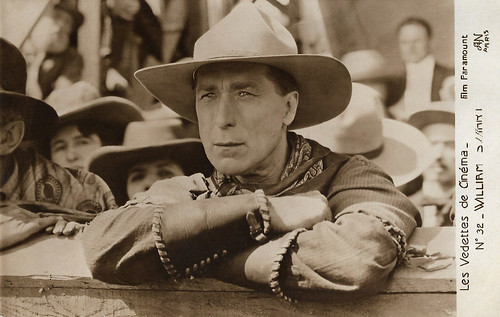
William S. Hart. French postcard by A.N. in the Les Vedettes de Cinéma series, Paris, no. 32. Photo: Film Paramount.
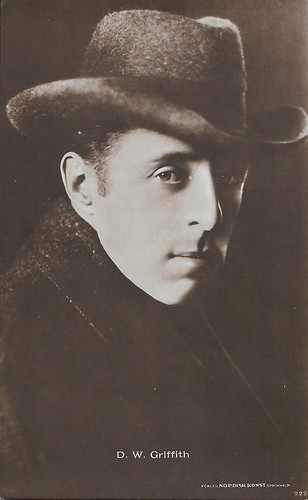
A rare portrait of the famous American film director D.W. Griffith. Swedish postcard by Förlag Nordisk Konst, Stockholm, no. 922.
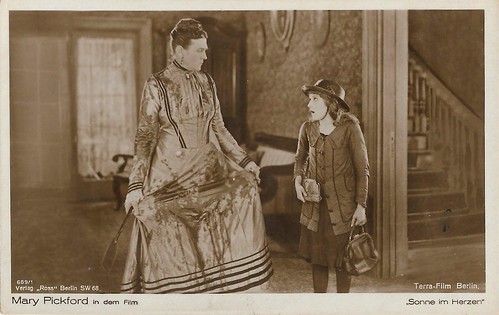
German postcard by Ross Verlag, Berlin, no. 689/1, 1919-1924. Photo: Terra-Film, Berlin. Publicity still of Katherine Griffith and Mary Pickford in the film Pollyanna (Paul Powell, 1920), released in Germany as Sonne im Herzen (Sunshine in her Heart).

German postcard by Ross Verlag, Berlin, no. 40/4. Photo: IFA / United Artists. Publicity still for The Thief of Bagdad (Raoul Walsh, 1924), featuring Douglas Fairbanks and with Julanne Johnston as the Princess.
In the spring of 1919, four of the most popular figures in the American cinema, director David Wark Griffith, Mary Pickford, Charlie Chaplin and Douglas Fairbanks incorporated United Artists as a joint venture. Each held a 25 percent stake in the preferred shares and a 20 percent stake in the common shares of the joint venture, with the remaining 20 percent of common shares held by lawyer and adviser William Gibbs McAdoo. The idea for the venture originated with Fairbanks, Chaplin, Pickford and cowboy star William S. Hart a year earlier. Already Hollywood veterans, the four stars talked of forming their own company to better control their own work.
They were spurred on by established Hollywood producers and distributors who were tightening their control over actor salaries and creative decisions, a process that evolved into the studio system. With the addition of Griffith, planning began, but Hart bowed out before anything was formalised. The four partners, with advice from McAdoo (son-in-law and former Treasury Secretary of then-President Woodrow Wilson), formed their distribution company. Hard-nosed executives were immensely sceptical right from the outset at the idea that artists and film-makers could run a studio. When he heard about their scheme, Richard A. Rowland, head of Metro Pictures, was quoted saying "The inmates are taking over the asylum." Richard Thomson in The Guardian: "It was a great line, but it was also an unfair assertion that the business was a crazy house - and thus beyond control. In fact, the idea was common sense, and that is why it has never gone away."
The original terms called for each star to produce five pictures a year. By the time the company was operational in 1921, feature films were becoming more expensive and polished, and running times had settled at around ninety minutes (eight reels). The original goal was thus abandoned. UA's first film, His Majesty, the American (Joseph Henabery, 1919), written by and starring Douglas Fairbanks, was a success. Mary Pickford gave UA plenty of product - Pollyanna (Paul Powell, 1920), Little Lord Fauntleroy (Alfred E. Green, Jack Pickford, 1921) and Tess of the Storm Country (John S. Robertson, 1922). Fairbanks delivered The Three Musketeers (Fred Niblo, 1921), Robin Hood (Allan Dwan, 1922) and the epic fantasy, The Thief of Bagdad (Raoul Walsh, 1924).
In addition, the UA logo carried the Griffith masterpieces Broken Blossoms (David Wark Griffith, 1919), Way Down East (David Wark Griffith, 1920) and Orphans of the Storm (David Wark Griffith, 1921), all starring Lillian Gish. The reputation of UA was growing. However, funding for films was limited. Without selling stock to the public like other studios, all United had for finance was weekly prepayment instalments from theatre owners for upcoming films. As a result, production was slow, and the company distributed an average of only five films a year in its first five years.
By 1924, Griffith had dropped out, and the company was facing a crisis. The alternatives were to either bring in others to help support a costly distribution system or concede defeat. Veteran producer Joseph Schenck was hired as president. He had produced pictures for a decade, and brought commitments for films starring his wife, Norma Talmadge, his sister-in-law, Constance Talmadge, and his brother-in-law, Buster Keaton. A few years later, UA could claim Sparrows (William Beaudine, 1926) in which Mary Pickford rescues a band of orphans from a swampy labour camp, Keaton's The General (Clyde Bruckman, Buster Keaton, 1927), Douglas Fairbanks in The Gaucho (F. Richard Jones, 1927) with Lupe Velez, and Gloria Swanson's production of Sadie Thompson (Raoul Walsh, 1928).
Inevitably, given that its founders were titans of the silent era, UA struggled to make the transition to sound film. Fairbanks and Keaton had faded away. Pickford concentrated on producing after she retired from acting. But Charles Chaplin created a perfect blend of comedy and melodrama in City Lights (Charles Chaplin, 1931), followed by his most socially engaged film, Modern Times (Charles Chaplin, 1936). Contracts were signed with independent producers, most notably Samuel Goldwyn, and Howard Hughes with his Hell's Angels (Howard Hughes, 1930) with Ben Lyon. UA also benefited from such newcomers as Alexander Korda, producing in England but breaking into the American market with The Private Life of Henry VIII (Alexander Korda, 1933) with Charles Laughton, The Scarlet Pimpernel (Harold Young, 1934) with Leslie Howard and Merle Oberon, and Things to Come (William Cameron Menzies, 1936). And in the mid-1930s, UA was reporting profits of over a million dollars a year.
In 1933, Schenck organised a new company with Darryl F. Zanuck, called Twentieth Century Pictures, which soon provided four pictures a year, forming half of UA's schedule. Schenck formed a separate partnership with Pickford and Chaplin to buy and build theatres under the United Artists name. They began international operations, first in Canada, and then in Mexico. By the end of the 1930s, United Artists was represented in over 40 countries. When he was denied an ownership share in 1935, Schenck resigned. He set up 20th Century Pictures' merger with Fox Film Corporation to form 20th Century Fox. Al Lichtman succeeded Schenck as company president. Other independent producers distributed through United Artists in the 1930s included Walt Disney Productions, Hal Roach, and Walter Wanger. In 1935 UA concluded a deal with David Selznick when he went independent. But as the years passed, and the dynamics of the business changed, these producing partners drifted away.
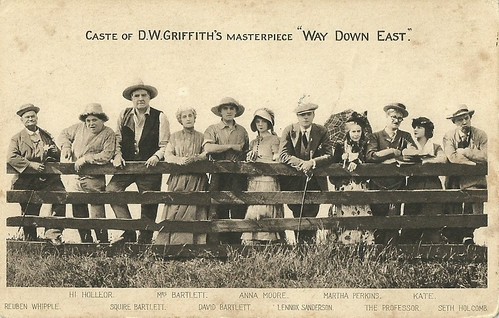
The cast of Way Down East (D.W. Griffith, 1920). British postcard by Cinema Art, London. From left to right, the actors George Neville, Edgar Nelson, Burr McIntosh, Kate Bruce, Richard Barthelmess, Lillian Gish, Lowell Sherman, Vivia Ogden, Creighton Hale, Mary Hay and Porter Strong.
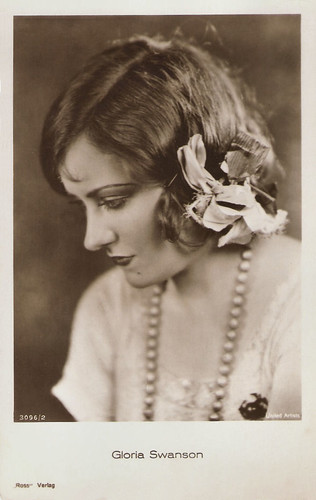
Gloria Swanson. German postcard by Ross Verlag, no. 3096/2, 1928-1929. Photo: United Artists. Publicity still for Sadie Thompson (Raoul Walsh, 1928).

Ronald Colman and Juliet Compton. British postcard in the Filmshots series by Film Weekly. Photo: United Artists. Publicity still for The Masquerader (Richard Wallace, 1933).
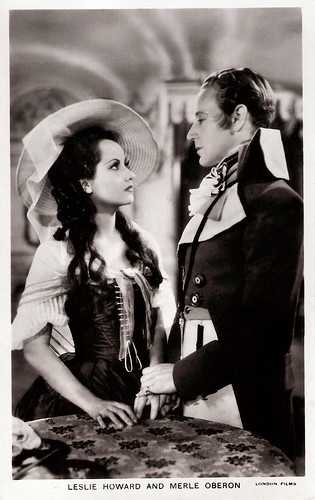
Leslie Howard and Merle Oberon. British postcard in the Film Partners Series, London, no. P 150. Photo: London Films. Publicity still for The Scarlet Pimpernel (Harold Young, 1934).
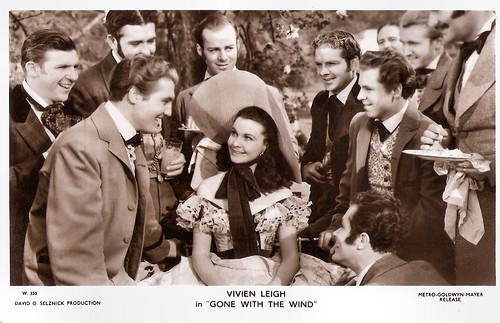
Vivien Leigh. British postcard in the Picturegoer Series, London, no. W. 350. Photo: David O'Selznick Production / Metro-Goldwyn-Mayer. Publicity still for Gone with the Wind (Victor Fleming, 1939).
In the late 1930s, United Artists turned a profit. Goldwyn was providing most of the output for distribution. He sued United several times for disputed compensation leading him to leave to RKO. Disney also went to RKO and Wanger to Universal Pictures. MGM's 1939 hit Gone with the Wind was supposed to be a UA release except that David O'Selznick wanted Clark Gable, who was under contract to MGM, to play Rhett Butler. Also that year, Fairbanks died. But the following year, Selznick's Rebecca (Alfred Hitchcock, 1940) did win the Best Picture Oscar, in a field where four other UA films were nominated - the Walter Wanger production Foreign Correspondent (Alfred Hitchcock, 1940), The Great Dictator (Charles Chaplin, 1940), Wanger's The Long Voyage Home (John Ford, 1940), and Sol Lesser's Our Town (Sam Wood, 1940). At that peak, UA had no studio and no theatres, but it was a focal point for independent producing, with over 20 films a year and a domestic gross exceeding $10m.
In 1941, Pickford, Chaplin, Disney, Orson Welles, Goldwyn, Selznick, Alexander Korda, and Wanger — many of whom were members of United Artists - formed the Society of Independent Motion Picture Producers (SIMPP). Later members included Hunt Stromberg, William Cagney, Sol Lesser, and Hal Roach. The Society aimed to advance the interests of independent producers in an industry controlled by the studio system. SIMPP fought to end ostensibly anti-competitive practices by the seven major film studios — Loew's (MGM), Columbia Pictures, Paramount Pictures, Universal Pictures, RKO Radio Pictures, 20th Century Fox, and Warner Bros./First National — that controlled the production, distribution, and exhibition of motion pictures.
In 1942, SIMPP filed an antitrust suit against Paramount's United Detroit Theatres. The complaint accused Paramount of conspiracy to control first-and subsequent-run theatres in Detroit. This was the first antitrust suit brought by producers against exhibitors that alleged monopoly and restraint of trade. In 1948, the U.S. Supreme Court Paramount Decision ordered the major Hollywood movie studios to sell their theatre chains and to end certain anti-competitive practices. This court ruling ended the studio system. By 1958, SIMPP achieved many of the goals that led to its creation, and the group ceased operations.
In the 1940s, United Artists became embroiled in lawsuits with Selznick over his distribution of some films through RKO. Selznick considered UA's operation sloppy, and left to start his own distribution arm. Cinema attendance continued to decline as television became more popular. Needing a turnaround, Pickford and Chaplin hired Paul V. McNutt, a former governor of Indiana, as chairman and Frank L. McNamee as president. McNutt did not have the skill to solve UA's financial problems and the pair was replaced after only a few months. On February 16, 1951, lawyers-turned-producers Arthur B. Krim of Eagle-Lion Films and Robert Benjamin came to Pickford and Chaplin, the surviving founders, with a proposal: let them take over United Artists for five years. If, at the end of those years, UA was profitable, they would earn an option to buy it. The aging stars agreed, and so began the busiest and richest period in the company’s history.
UA flourished and carried some remarkable films, all of which had reason to be grateful for the extra independence they enjoyed. In taking over UA, Krim and Benjamin created the first studio without an actual studio. Fox Film Corporation president Spyros Skouras extended United Artists a $3 million loan through Krim and Benjamin's efforts.Primarily acting as bankers, they offered money to independent producers. UA leased space at the Pickford/Fairbanks Studio but did not own a studio lot. Thus UA did not have the overhead, the maintenance, or the expensive production staff at other studios. They had two hits, The African Queen (John Huston, 1951) with Humphrey Bogart and Katharine Hepburn, and High Noon (Fred Zinnemann, 1952) with Gary Cooper and Grace Kelly, turning a profit in their first year. Among their first clients were Sam Spiegel and John Huston, whose Horizon Productions gave UA one major hit, The African Queen (John Huston, 1951) and a substantial success, Moulin Rouge (John Huston, 1952) with José Ferrer.
Other clients were Stanley Kramer, Otto Preminger, Hecht-Hill-Lancaster — a production company Burt Lancaster founded with his agent, Harold Hecht, and the writer-producer James Hill — , and actors newly freed from studio contracts and seeking to produce or direct their own films. It resulted in prestige productions like The Man With the Golden Arm (Otto Preminger, 1955) starring Frank Sinatra and Kim Novak, The Defiant Ones (Stanley Kramer, 1958) with Tony Curtis and Sidney Poitier, and Marty (Delbert Mann, 1955) which gave United Artists its first best-picture Oscar.
With the instability in the film industry due to theatre divestment, the business was considered risky. In 1955, film attendance reached its lowest level since 1923. Chaplin sold his 25 percent share during this crisis to Krim and Benjamin for $1.1 million, followed a year later by Pickford who sold her share for $3 million. In these years, Stanley Kubrick made two of his important early films for the studio, The Killing (Stanley Kubrick, 1956) and Paths of Glory (Stanley Kubrick, 1957), with Kirk Douglas. Another interesting film was Charles Laughton’s sublime, heartfelt homage to D.W. Griffith, Night of the Hunter (Charles Laughton, 1955), starring Robert Mitchum.
In 1957, United Artists went public with a $17 million stock and debenture offering. The company was averaging 50 films a year. In 1958, UA acquired Ilya Lopert's Lopert Pictures Corporation, which released foreign films that attracted criticism or had censorship problems. In 1959, after failing to sell several pilots, United Artists offered its first ever television series, The Troubleshooters, and later released its first sitcom, The Dennis O'Keefe Show. In the cinema there were successes with Witness for the Prosecution (Billy Wilder, 1957), and Some Like It Hot (Billy Wilder, 1959), starring Marilyn Monroe, Jack Lemmon and Tony Curtis.

Lupe Velez. French postcard by Europe, no. 470. Photo: Regal Film United Artists.

Carmen Miranda. British postcard in 'The People' series by Show Parade Picture Service, London, no. P. 1051. Photo: Virgil Apger / United Artists.
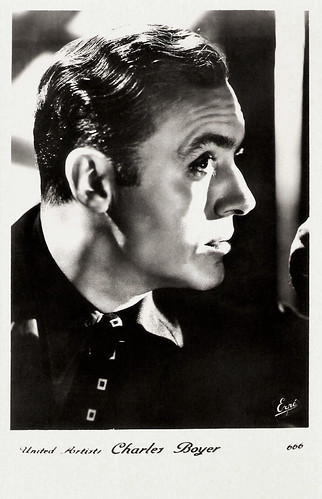
Charles Boyer. French postcard by Erpé, no. 666. Photo: United Artists. Publicity still for Algiers (John Cromwell, 1938).

Charles Chaplin. Dutch postcard. Sent by mail in the Netherlands in 1948. Photo: publicity still for The Great Dictator (Charles Chaplin, 1940).
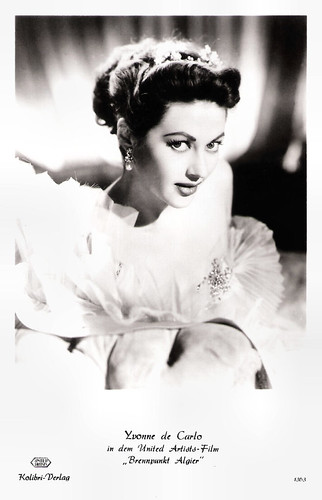
Yvonne De Carlo. German postcard by Kolibri-Verlag, no. 1363. Photo: United Artists. Publicity still for Fort Algiers (Lesley Selander, 1953).
In the 1960s, mainstream studios fell into decline and some were acquired or diversified. UA prospered while winning 11 Academy Awards, including five for Best Picture, adding relationships with the Mirisch brothers, Billy Wilder, Joseph E. Levine and others. In 1961, United Artists released West Side Story (Robert Wise, 1961), which won a record ten Academy Awards including Best Picture. Because United Artists did not feel constrained by the moral strictures of the Production Code, it was able to move quickly as social mores changed in the 1960s. In those heady days it released films like The Apartment (Billy Wilder, 1960), Tom Jones (Tony Richardson, 1963), and The Manchurian Candidate (John Frankenheimer, 1962), films with a sexual and political edge that the more conservative majors could not equal.
UA's television division was responsible for shows such as Gilligan's Island, The Fugitive, Outer Limits, and The Patty Duke Show. The television unit had begun to build up a profitable rental library, including Associated Artists Productions, owners of Warner Bros. pre-1950 features, shorts and cartoons and 231 Popeye cartoon shorts purchased from Paramount Pictures in 1958, becoming United Artists Associated, its distribution division.
In 1963, UA released two Stanley Kramer films, It's A Mad, Mad, Mad, Mad World (Stanley Kramer, 1963) with Spencer Tracy, and A Child Is Waiting (John Cassavetes, 1963) with Burt Lancaster and Judy Garland. In 1964, UA introduced U.S. film audiences to The Beatles by releasing A Hard Day's Night (Richard Lester, 1964) and Help! (Richard Lester, 1965). At the same time, it backed two expatriate North Americans in Britain, who had acquired screen rights to Ian Fleming's James Bond novels. For $1 million, UA backed Harry Saltzman and Albert Broccoli's Dr. No in 1963 and launched the James Bond franchise. The franchise outlived UA's time as a major studio, continuing half a century later. Other successful projects backed in this period included the Pink Panther series, which began in 1964, and Spaghetti Westerns, which made a star of Clint Eastwood.
On the basis of its film and television hits, in 1967, Transamerica Corporation purchased 98 percent of UA's stock. Transamerica selected David and Arnold Picker to lead its studio. UA debuted a new logo incorporating the parent company's striped T emblem and the tagline "Entertainment from Transamerica Corporation". UA released another Best Picture Oscar winner in 1967, In the Heat of the Night (Norman Jewison, 1967) starring Sidney Poitier, and a nominee for Best Picture, The Graduate (Mike Nichols, 1967), an Embassy production that UA distributed overseas. In 1970, UA lost $35 million; thus the Pickers were pushed aside for the return of Krim and Benjamin. Other successful pictures included the screen version of Fiddler on the Roof (Norman Jewison, 1971). However, the film version of Man of La Mancha (Arthur Hiller, 1972) with Peter O'Toole and Sophia Loren, was a failure. New talent was encouraged, including Woody Allen, Robert Altman, Sylvester Stallone, Saul Zaentz, Miloš Forman, and Brian De Palma. In 1973, United Artists took over the sales and distribution of MGM's films in Anglo-America.
In 1975, Harry Saltzman sold UA his 50 percent stake in Danjaq, the holding-company for the Bond films. UA was to remain a silent partner, providing money, while Albert Broccoli took producer credit. Danjaq and UA remained the public co-copyright holders for the Bond series, and the 2006 Casino Royale (Martin Campbell, 2006) remake shares the copyright with Columbia Pictures. UA released One Flew Over the Cuckoo's Nest (Milos Forman, 1975) with Jack Nicholson, which won the Best Picture Academy Award and earned $56 million. UA followed with the next two years' Best Picture Oscar winners, Rocky (John G. Avildsen, 1976) and Annie Hall (Woody Allen, 1977).
However, Transamerica was not pleased with UA's releases such as Midnight Cowboy (John Schlesinger, 1969) and the sexually explicit Ultimo tango a Parigi/Last Tango in Paris (Bernardo Bertolucci, 1972) with Marlon Brando, that were rated X by the Motion Picture Association of America. In these instances, Transamerica demanded the byline 'A Transamerica Company' be removed on the prints and in all advertising. At one point, the parent company expressed its desire to phase out the UA name and replace it with Transamerica Films. Krim tried to convince Transamerica to spin off United Artists, but he and Transamerica's chairman could not come to an agreement.
Finally in 1978, following a dispute with Transamerica chief John R. Beckett over administrative expenses, UA's top executives, including chairman Krim, president Eric Pleskow, Benjamin and other key officers walked out. Within days they announced the formation of Orion Pictures, with backing from Warner. The departures concerned several Hollywood figures enough that they took out an ad in a trade paper warning Transamerica that it had made a fatal mistake in letting them go. Transamerica inserted Andy Albeck as UA's president. UA remained courageous and enterprising, reflected in Coming Home (Hal Ashby, 1978), Apocalypse Now (Francis Coppola, 1979) and Raging Bull (Martin Scorsese, 1980) starring Robert de Niro.
United had its most successful year with four hits in 1979: Rocky II (Sylvester Stallone, 1979), Manhattan (Woody Allen, 1979), Moonraker (Lewis Gilbert, 1979), and The Black Stallion (Carroll Ballard, 1979). The new leadership had also agreed to back Heaven's Gate (1980), the pet project of director Michael Cimino. Cimino was regarded as a genius after The Deer Hunter (Michael Cimino, 1978) starring Robert de Niro. Initially set to cost about $6m, it ended up at least five times as expensive. Long before its release, it became a laughing stock and the worst example of Hollywood extravagance. This led to the resignation of Albeck who was replaced by Norbert Auerbach. United Artists recorded a major loss for the year due almost entirely to this fiasco. In 1980, Transamerica decided to exit the film making business, and put United Artists on the market.
That was the end of the great days. In 1981, TransAmerica sold the shell of UA to MGM, itself in free fall. In 1983 the two studios were merged to become MGM/UA Entertainment. In 1988, UA released another Best Picture winner, Rain Man (Barry Levinson, 1988), starring Tom Cruise and Dustin Hoffman. Somehow, United Artists remained the maverick studio until the 1990s, when it became a financial football, kicked around by various bankers, promoters and avaricious studios. The current United Artists company exists as a successor to the original as a provider of digital content, in addition to handling most of its post-1952 in-house library and other content it has since acquired.
Next year, United Artists will turn 100, having survived countless transformations and takeovers since the company released its first feature in 1919. David Thomson in The Guardian: "So it's time enough to propose one large birthday wish - that the jokes about the idiots and the asylum be retired, and the lesson learned, that the most creative people in the picture business should do all they can to look after each other. No one else is going to do it."

George Chakiris. Spanish postcard by Archivo Bermejo, no. C. 65, 1963. Photo: United Artists. Publicity still for West Side Story (Robert Wise, 1961).

Burt Lancaster. German postcard by Ufa, Berlin-Tempelhof, no. CK-156. Photo: Sam Lévin.

John Lennon and George Harrison of The Beatles. Spanish postcard by Oscarcolor, no. 347.

British postcard by Hotstamp Free Postcards, 1998. Image: United Artists. Caption: Too sexy for his fur. The colour of Cool Pink Panther.
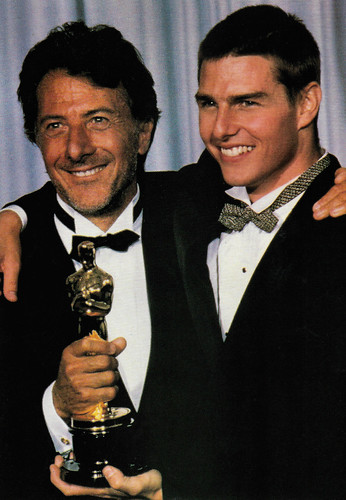
French postcard, no. SL. 4037. The Academy Awards Ceremony 1989: Dustin Hoffman wins Best Actor Oscar for Rain Man' (Barry Levinson, 1988), with co-star Tom Cruise.
Sources: David Thomson (The Guardian), Geoffrey Macnab (The Independent), Dave Kehr (The New York Times), History.com, Encyclopaedia Britannica, and Wikipedia.

Charlie Chaplin, Mary Pickford and Douglas Fairbanks. French postcard in the Les Vedettes de Cinéma series by A.N., Paris, no. 85. Photo: United Artists.

William S. Hart. French postcard by A.N. in the Les Vedettes de Cinéma series, Paris, no. 32. Photo: Film Paramount.

A rare portrait of the famous American film director D.W. Griffith. Swedish postcard by Förlag Nordisk Konst, Stockholm, no. 922.

German postcard by Ross Verlag, Berlin, no. 689/1, 1919-1924. Photo: Terra-Film, Berlin. Publicity still of Katherine Griffith and Mary Pickford in the film Pollyanna (Paul Powell, 1920), released in Germany as Sonne im Herzen (Sunshine in her Heart).

German postcard by Ross Verlag, Berlin, no. 40/4. Photo: IFA / United Artists. Publicity still for The Thief of Bagdad (Raoul Walsh, 1924), featuring Douglas Fairbanks and with Julanne Johnston as the Princess.
The inmates are taking over the asylum
In the spring of 1919, four of the most popular figures in the American cinema, director David Wark Griffith, Mary Pickford, Charlie Chaplin and Douglas Fairbanks incorporated United Artists as a joint venture. Each held a 25 percent stake in the preferred shares and a 20 percent stake in the common shares of the joint venture, with the remaining 20 percent of common shares held by lawyer and adviser William Gibbs McAdoo. The idea for the venture originated with Fairbanks, Chaplin, Pickford and cowboy star William S. Hart a year earlier. Already Hollywood veterans, the four stars talked of forming their own company to better control their own work.
They were spurred on by established Hollywood producers and distributors who were tightening their control over actor salaries and creative decisions, a process that evolved into the studio system. With the addition of Griffith, planning began, but Hart bowed out before anything was formalised. The four partners, with advice from McAdoo (son-in-law and former Treasury Secretary of then-President Woodrow Wilson), formed their distribution company. Hard-nosed executives were immensely sceptical right from the outset at the idea that artists and film-makers could run a studio. When he heard about their scheme, Richard A. Rowland, head of Metro Pictures, was quoted saying "The inmates are taking over the asylum." Richard Thomson in The Guardian: "It was a great line, but it was also an unfair assertion that the business was a crazy house - and thus beyond control. In fact, the idea was common sense, and that is why it has never gone away."
The original terms called for each star to produce five pictures a year. By the time the company was operational in 1921, feature films were becoming more expensive and polished, and running times had settled at around ninety minutes (eight reels). The original goal was thus abandoned. UA's first film, His Majesty, the American (Joseph Henabery, 1919), written by and starring Douglas Fairbanks, was a success. Mary Pickford gave UA plenty of product - Pollyanna (Paul Powell, 1920), Little Lord Fauntleroy (Alfred E. Green, Jack Pickford, 1921) and Tess of the Storm Country (John S. Robertson, 1922). Fairbanks delivered The Three Musketeers (Fred Niblo, 1921), Robin Hood (Allan Dwan, 1922) and the epic fantasy, The Thief of Bagdad (Raoul Walsh, 1924).
In addition, the UA logo carried the Griffith masterpieces Broken Blossoms (David Wark Griffith, 1919), Way Down East (David Wark Griffith, 1920) and Orphans of the Storm (David Wark Griffith, 1921), all starring Lillian Gish. The reputation of UA was growing. However, funding for films was limited. Without selling stock to the public like other studios, all United had for finance was weekly prepayment instalments from theatre owners for upcoming films. As a result, production was slow, and the company distributed an average of only five films a year in its first five years.
By 1924, Griffith had dropped out, and the company was facing a crisis. The alternatives were to either bring in others to help support a costly distribution system or concede defeat. Veteran producer Joseph Schenck was hired as president. He had produced pictures for a decade, and brought commitments for films starring his wife, Norma Talmadge, his sister-in-law, Constance Talmadge, and his brother-in-law, Buster Keaton. A few years later, UA could claim Sparrows (William Beaudine, 1926) in which Mary Pickford rescues a band of orphans from a swampy labour camp, Keaton's The General (Clyde Bruckman, Buster Keaton, 1927), Douglas Fairbanks in The Gaucho (F. Richard Jones, 1927) with Lupe Velez, and Gloria Swanson's production of Sadie Thompson (Raoul Walsh, 1928).
Inevitably, given that its founders were titans of the silent era, UA struggled to make the transition to sound film. Fairbanks and Keaton had faded away. Pickford concentrated on producing after she retired from acting. But Charles Chaplin created a perfect blend of comedy and melodrama in City Lights (Charles Chaplin, 1931), followed by his most socially engaged film, Modern Times (Charles Chaplin, 1936). Contracts were signed with independent producers, most notably Samuel Goldwyn, and Howard Hughes with his Hell's Angels (Howard Hughes, 1930) with Ben Lyon. UA also benefited from such newcomers as Alexander Korda, producing in England but breaking into the American market with The Private Life of Henry VIII (Alexander Korda, 1933) with Charles Laughton, The Scarlet Pimpernel (Harold Young, 1934) with Leslie Howard and Merle Oberon, and Things to Come (William Cameron Menzies, 1936). And in the mid-1930s, UA was reporting profits of over a million dollars a year.
In 1933, Schenck organised a new company with Darryl F. Zanuck, called Twentieth Century Pictures, which soon provided four pictures a year, forming half of UA's schedule. Schenck formed a separate partnership with Pickford and Chaplin to buy and build theatres under the United Artists name. They began international operations, first in Canada, and then in Mexico. By the end of the 1930s, United Artists was represented in over 40 countries. When he was denied an ownership share in 1935, Schenck resigned. He set up 20th Century Pictures' merger with Fox Film Corporation to form 20th Century Fox. Al Lichtman succeeded Schenck as company president. Other independent producers distributed through United Artists in the 1930s included Walt Disney Productions, Hal Roach, and Walter Wanger. In 1935 UA concluded a deal with David Selznick when he went independent. But as the years passed, and the dynamics of the business changed, these producing partners drifted away.

The cast of Way Down East (D.W. Griffith, 1920). British postcard by Cinema Art, London. From left to right, the actors George Neville, Edgar Nelson, Burr McIntosh, Kate Bruce, Richard Barthelmess, Lillian Gish, Lowell Sherman, Vivia Ogden, Creighton Hale, Mary Hay and Porter Strong.

Gloria Swanson. German postcard by Ross Verlag, no. 3096/2, 1928-1929. Photo: United Artists. Publicity still for Sadie Thompson (Raoul Walsh, 1928).

Ronald Colman and Juliet Compton. British postcard in the Filmshots series by Film Weekly. Photo: United Artists. Publicity still for The Masquerader (Richard Wallace, 1933).

Leslie Howard and Merle Oberon. British postcard in the Film Partners Series, London, no. P 150. Photo: London Films. Publicity still for The Scarlet Pimpernel (Harold Young, 1934).

Vivien Leigh. British postcard in the Picturegoer Series, London, no. W. 350. Photo: David O'Selznick Production / Metro-Goldwyn-Mayer. Publicity still for Gone with the Wind (Victor Fleming, 1939).
A focal point for independent producing
In the late 1930s, United Artists turned a profit. Goldwyn was providing most of the output for distribution. He sued United several times for disputed compensation leading him to leave to RKO. Disney also went to RKO and Wanger to Universal Pictures. MGM's 1939 hit Gone with the Wind was supposed to be a UA release except that David O'Selznick wanted Clark Gable, who was under contract to MGM, to play Rhett Butler. Also that year, Fairbanks died. But the following year, Selznick's Rebecca (Alfred Hitchcock, 1940) did win the Best Picture Oscar, in a field where four other UA films were nominated - the Walter Wanger production Foreign Correspondent (Alfred Hitchcock, 1940), The Great Dictator (Charles Chaplin, 1940), Wanger's The Long Voyage Home (John Ford, 1940), and Sol Lesser's Our Town (Sam Wood, 1940). At that peak, UA had no studio and no theatres, but it was a focal point for independent producing, with over 20 films a year and a domestic gross exceeding $10m.
In 1941, Pickford, Chaplin, Disney, Orson Welles, Goldwyn, Selznick, Alexander Korda, and Wanger — many of whom were members of United Artists - formed the Society of Independent Motion Picture Producers (SIMPP). Later members included Hunt Stromberg, William Cagney, Sol Lesser, and Hal Roach. The Society aimed to advance the interests of independent producers in an industry controlled by the studio system. SIMPP fought to end ostensibly anti-competitive practices by the seven major film studios — Loew's (MGM), Columbia Pictures, Paramount Pictures, Universal Pictures, RKO Radio Pictures, 20th Century Fox, and Warner Bros./First National — that controlled the production, distribution, and exhibition of motion pictures.
In 1942, SIMPP filed an antitrust suit against Paramount's United Detroit Theatres. The complaint accused Paramount of conspiracy to control first-and subsequent-run theatres in Detroit. This was the first antitrust suit brought by producers against exhibitors that alleged monopoly and restraint of trade. In 1948, the U.S. Supreme Court Paramount Decision ordered the major Hollywood movie studios to sell their theatre chains and to end certain anti-competitive practices. This court ruling ended the studio system. By 1958, SIMPP achieved many of the goals that led to its creation, and the group ceased operations.
In the 1940s, United Artists became embroiled in lawsuits with Selznick over his distribution of some films through RKO. Selznick considered UA's operation sloppy, and left to start his own distribution arm. Cinema attendance continued to decline as television became more popular. Needing a turnaround, Pickford and Chaplin hired Paul V. McNutt, a former governor of Indiana, as chairman and Frank L. McNamee as president. McNutt did not have the skill to solve UA's financial problems and the pair was replaced after only a few months. On February 16, 1951, lawyers-turned-producers Arthur B. Krim of Eagle-Lion Films and Robert Benjamin came to Pickford and Chaplin, the surviving founders, with a proposal: let them take over United Artists for five years. If, at the end of those years, UA was profitable, they would earn an option to buy it. The aging stars agreed, and so began the busiest and richest period in the company’s history.
UA flourished and carried some remarkable films, all of which had reason to be grateful for the extra independence they enjoyed. In taking over UA, Krim and Benjamin created the first studio without an actual studio. Fox Film Corporation president Spyros Skouras extended United Artists a $3 million loan through Krim and Benjamin's efforts.Primarily acting as bankers, they offered money to independent producers. UA leased space at the Pickford/Fairbanks Studio but did not own a studio lot. Thus UA did not have the overhead, the maintenance, or the expensive production staff at other studios. They had two hits, The African Queen (John Huston, 1951) with Humphrey Bogart and Katharine Hepburn, and High Noon (Fred Zinnemann, 1952) with Gary Cooper and Grace Kelly, turning a profit in their first year. Among their first clients were Sam Spiegel and John Huston, whose Horizon Productions gave UA one major hit, The African Queen (John Huston, 1951) and a substantial success, Moulin Rouge (John Huston, 1952) with José Ferrer.
Other clients were Stanley Kramer, Otto Preminger, Hecht-Hill-Lancaster — a production company Burt Lancaster founded with his agent, Harold Hecht, and the writer-producer James Hill — , and actors newly freed from studio contracts and seeking to produce or direct their own films. It resulted in prestige productions like The Man With the Golden Arm (Otto Preminger, 1955) starring Frank Sinatra and Kim Novak, The Defiant Ones (Stanley Kramer, 1958) with Tony Curtis and Sidney Poitier, and Marty (Delbert Mann, 1955) which gave United Artists its first best-picture Oscar.
With the instability in the film industry due to theatre divestment, the business was considered risky. In 1955, film attendance reached its lowest level since 1923. Chaplin sold his 25 percent share during this crisis to Krim and Benjamin for $1.1 million, followed a year later by Pickford who sold her share for $3 million. In these years, Stanley Kubrick made two of his important early films for the studio, The Killing (Stanley Kubrick, 1956) and Paths of Glory (Stanley Kubrick, 1957), with Kirk Douglas. Another interesting film was Charles Laughton’s sublime, heartfelt homage to D.W. Griffith, Night of the Hunter (Charles Laughton, 1955), starring Robert Mitchum.
In 1957, United Artists went public with a $17 million stock and debenture offering. The company was averaging 50 films a year. In 1958, UA acquired Ilya Lopert's Lopert Pictures Corporation, which released foreign films that attracted criticism or had censorship problems. In 1959, after failing to sell several pilots, United Artists offered its first ever television series, The Troubleshooters, and later released its first sitcom, The Dennis O'Keefe Show. In the cinema there were successes with Witness for the Prosecution (Billy Wilder, 1957), and Some Like It Hot (Billy Wilder, 1959), starring Marilyn Monroe, Jack Lemmon and Tony Curtis.

Lupe Velez. French postcard by Europe, no. 470. Photo: Regal Film United Artists.

Carmen Miranda. British postcard in 'The People' series by Show Parade Picture Service, London, no. P. 1051. Photo: Virgil Apger / United Artists.

Charles Boyer. French postcard by Erpé, no. 666. Photo: United Artists. Publicity still for Algiers (John Cromwell, 1938).

Charles Chaplin. Dutch postcard. Sent by mail in the Netherlands in 1948. Photo: publicity still for The Great Dictator (Charles Chaplin, 1940).

Yvonne De Carlo. German postcard by Kolibri-Verlag, no. 1363. Photo: United Artists. Publicity still for Fort Algiers (Lesley Selander, 1953).
The end of the great days
In the 1960s, mainstream studios fell into decline and some were acquired or diversified. UA prospered while winning 11 Academy Awards, including five for Best Picture, adding relationships with the Mirisch brothers, Billy Wilder, Joseph E. Levine and others. In 1961, United Artists released West Side Story (Robert Wise, 1961), which won a record ten Academy Awards including Best Picture. Because United Artists did not feel constrained by the moral strictures of the Production Code, it was able to move quickly as social mores changed in the 1960s. In those heady days it released films like The Apartment (Billy Wilder, 1960), Tom Jones (Tony Richardson, 1963), and The Manchurian Candidate (John Frankenheimer, 1962), films with a sexual and political edge that the more conservative majors could not equal.
UA's television division was responsible for shows such as Gilligan's Island, The Fugitive, Outer Limits, and The Patty Duke Show. The television unit had begun to build up a profitable rental library, including Associated Artists Productions, owners of Warner Bros. pre-1950 features, shorts and cartoons and 231 Popeye cartoon shorts purchased from Paramount Pictures in 1958, becoming United Artists Associated, its distribution division.
In 1963, UA released two Stanley Kramer films, It's A Mad, Mad, Mad, Mad World (Stanley Kramer, 1963) with Spencer Tracy, and A Child Is Waiting (John Cassavetes, 1963) with Burt Lancaster and Judy Garland. In 1964, UA introduced U.S. film audiences to The Beatles by releasing A Hard Day's Night (Richard Lester, 1964) and Help! (Richard Lester, 1965). At the same time, it backed two expatriate North Americans in Britain, who had acquired screen rights to Ian Fleming's James Bond novels. For $1 million, UA backed Harry Saltzman and Albert Broccoli's Dr. No in 1963 and launched the James Bond franchise. The franchise outlived UA's time as a major studio, continuing half a century later. Other successful projects backed in this period included the Pink Panther series, which began in 1964, and Spaghetti Westerns, which made a star of Clint Eastwood.
On the basis of its film and television hits, in 1967, Transamerica Corporation purchased 98 percent of UA's stock. Transamerica selected David and Arnold Picker to lead its studio. UA debuted a new logo incorporating the parent company's striped T emblem and the tagline "Entertainment from Transamerica Corporation". UA released another Best Picture Oscar winner in 1967, In the Heat of the Night (Norman Jewison, 1967) starring Sidney Poitier, and a nominee for Best Picture, The Graduate (Mike Nichols, 1967), an Embassy production that UA distributed overseas. In 1970, UA lost $35 million; thus the Pickers were pushed aside for the return of Krim and Benjamin. Other successful pictures included the screen version of Fiddler on the Roof (Norman Jewison, 1971). However, the film version of Man of La Mancha (Arthur Hiller, 1972) with Peter O'Toole and Sophia Loren, was a failure. New talent was encouraged, including Woody Allen, Robert Altman, Sylvester Stallone, Saul Zaentz, Miloš Forman, and Brian De Palma. In 1973, United Artists took over the sales and distribution of MGM's films in Anglo-America.
In 1975, Harry Saltzman sold UA his 50 percent stake in Danjaq, the holding-company for the Bond films. UA was to remain a silent partner, providing money, while Albert Broccoli took producer credit. Danjaq and UA remained the public co-copyright holders for the Bond series, and the 2006 Casino Royale (Martin Campbell, 2006) remake shares the copyright with Columbia Pictures. UA released One Flew Over the Cuckoo's Nest (Milos Forman, 1975) with Jack Nicholson, which won the Best Picture Academy Award and earned $56 million. UA followed with the next two years' Best Picture Oscar winners, Rocky (John G. Avildsen, 1976) and Annie Hall (Woody Allen, 1977).
However, Transamerica was not pleased with UA's releases such as Midnight Cowboy (John Schlesinger, 1969) and the sexually explicit Ultimo tango a Parigi/Last Tango in Paris (Bernardo Bertolucci, 1972) with Marlon Brando, that were rated X by the Motion Picture Association of America. In these instances, Transamerica demanded the byline 'A Transamerica Company' be removed on the prints and in all advertising. At one point, the parent company expressed its desire to phase out the UA name and replace it with Transamerica Films. Krim tried to convince Transamerica to spin off United Artists, but he and Transamerica's chairman could not come to an agreement.
Finally in 1978, following a dispute with Transamerica chief John R. Beckett over administrative expenses, UA's top executives, including chairman Krim, president Eric Pleskow, Benjamin and other key officers walked out. Within days they announced the formation of Orion Pictures, with backing from Warner. The departures concerned several Hollywood figures enough that they took out an ad in a trade paper warning Transamerica that it had made a fatal mistake in letting them go. Transamerica inserted Andy Albeck as UA's president. UA remained courageous and enterprising, reflected in Coming Home (Hal Ashby, 1978), Apocalypse Now (Francis Coppola, 1979) and Raging Bull (Martin Scorsese, 1980) starring Robert de Niro.
United had its most successful year with four hits in 1979: Rocky II (Sylvester Stallone, 1979), Manhattan (Woody Allen, 1979), Moonraker (Lewis Gilbert, 1979), and The Black Stallion (Carroll Ballard, 1979). The new leadership had also agreed to back Heaven's Gate (1980), the pet project of director Michael Cimino. Cimino was regarded as a genius after The Deer Hunter (Michael Cimino, 1978) starring Robert de Niro. Initially set to cost about $6m, it ended up at least five times as expensive. Long before its release, it became a laughing stock and the worst example of Hollywood extravagance. This led to the resignation of Albeck who was replaced by Norbert Auerbach. United Artists recorded a major loss for the year due almost entirely to this fiasco. In 1980, Transamerica decided to exit the film making business, and put United Artists on the market.
That was the end of the great days. In 1981, TransAmerica sold the shell of UA to MGM, itself in free fall. In 1983 the two studios were merged to become MGM/UA Entertainment. In 1988, UA released another Best Picture winner, Rain Man (Barry Levinson, 1988), starring Tom Cruise and Dustin Hoffman. Somehow, United Artists remained the maverick studio until the 1990s, when it became a financial football, kicked around by various bankers, promoters and avaricious studios. The current United Artists company exists as a successor to the original as a provider of digital content, in addition to handling most of its post-1952 in-house library and other content it has since acquired.
Next year, United Artists will turn 100, having survived countless transformations and takeovers since the company released its first feature in 1919. David Thomson in The Guardian: "So it's time enough to propose one large birthday wish - that the jokes about the idiots and the asylum be retired, and the lesson learned, that the most creative people in the picture business should do all they can to look after each other. No one else is going to do it."

George Chakiris. Spanish postcard by Archivo Bermejo, no. C. 65, 1963. Photo: United Artists. Publicity still for West Side Story (Robert Wise, 1961).

Burt Lancaster. German postcard by Ufa, Berlin-Tempelhof, no. CK-156. Photo: Sam Lévin.

John Lennon and George Harrison of The Beatles. Spanish postcard by Oscarcolor, no. 347.

British postcard by Hotstamp Free Postcards, 1998. Image: United Artists. Caption: Too sexy for his fur. The colour of Cool Pink Panther.

French postcard, no. SL. 4037. The Academy Awards Ceremony 1989: Dustin Hoffman wins Best Actor Oscar for Rain Man' (Barry Levinson, 1988), with co-star Tom Cruise.
Sources: David Thomson (The Guardian), Geoffrey Macnab (The Independent), Dave Kehr (The New York Times), History.com, Encyclopaedia Britannica, and Wikipedia.
No comments:
Post a Comment